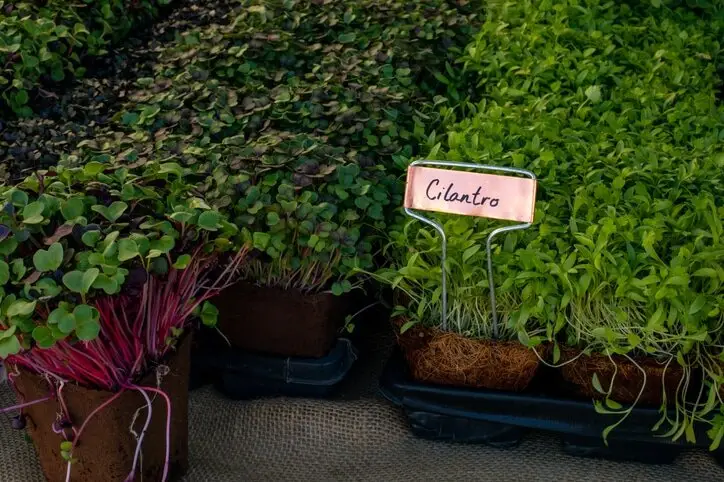Microgreens 101: How to select the best microgreen seeds for your needs

Microgreens have gained popularity in recent years for their intense flavour, high nutritional value, and versatility in the kitchen. These tiny plants are easy to grow and can be used as a garnish or ingredient in various dishes. But with so many types of microgreen seeds available on the market, selecting the best ones for your needs can be challenging. In this article, we’ll cover the basics of microgreen seeds and provide some tips on choosing suitable sources for your microgreen garden.
What are Microgreens?
Microgreens are young vegetable or herb plants that are harvested when they are just a few inches tall and have produced their first set of true leaves. They are typically grown in soil or a growing medium and can be harvested in as little as one to three weeks. Microgreens are packed with flavour and nutrition, often containing higher concentrations of vitamins, minerals, and antioxidants than their mature counterparts. They are commonly used in salads, sandwiches, smoothies, and other dishes to add a fresh, delicate flavour and a pop of colour.
Types of Microgreen Seeds
Numerous types of microgreen seeds are available on the market, ranging from common garden vegetables to more exotic herbs and spices.
Natural Yield specializes in providing high-quality, organic microgreen seeds. We offer a wide variety of microgreen seeds, including popular options like radish, sunflower, and pea, as well as more unique options like fenugreek, chickpea, and amaranth.
Here are some of the microgreen seeds available on the Natural Yield website and their respective benefits:
- Radish: Radish microgreens have a spicy, peppery flavour and are rich in vitamins A, C, and K, as well as calcium, iron, and potassium. They can be harvested in as little as 5-7 days and are a great addition to salads, sandwiches, and wraps.
- Sunflower: Sunflower microgreens have a nutty, earthy flavour and are rich in vitamins B, C, and E, as well as calcium, iron, and magnesium. They can be harvested in 10-14 days and are a great addition to smoothies, salads, and sandwiches.
- Pea: Pea microgreens have a sweet, delicate flavour and are packed with protein, vitamins C and K, and fibre. They can be harvested in 10-14 days and are a great addition to salads, soups, and stir-fries.
- Fenugreek: Fenugreek microgreens have a nutty, slightly sweet flavour and are rich in vitamins A, C, and E, as well as calcium, iron, and magnesium. They can be harvested in 7-10 days and are a great addition to curries, stews, and salads.
- Chickpea: Chickpea microgreens have a nutty, earthy flavour and are rich in protein, fibre, and vitamins A and C. They can be harvested in 10-14 days and are a great addition to salads, sandwiches, and wraps.
- Amaranth: Amaranth microgreens have a nutty, slightly sweet flavour and are rich in vitamins C and K, as well as calcium, iron, and magnesium. They can be harvested in 7-10 days and are a great addition to salads, soups, and stir-fries.
These are just a few microgreen seeds on the Natural Yield website. We also offer a range of organic microgreen growing kits, including a “beginner’s kit” with seeds for radish, sunflower, and pea microgreens, organic soil, growing trays, and instructions.
Overall, Natural Yield offers diverse, high-quality microgreen seeds to help you grow a thriving microgreen garden. When selecting seeds, consider the flavour profile, growing time, yield, and quality to ensure you choose the best seeds for your needs. You can enjoy a bountiful harvest of delicious, nutrient-packed microgreens with a bit of care and attention.
Tips for Choosing Microgreen Seeds
When selecting microgreen seeds for your garden, there are a few factors to consider:
- Flavour: Consider the flavour profile of the microgreen and how it will complement the dishes you plan to use it in. Some microgreens, like radish and arugula, have a spicy, peppery flavour, while others, like sunflower and pea, have a sweeter, nuttier flavour.
- Growing time: Consider the amount of time it takes for the microgreens to reach maturity. Some microgreens, like radish and arugula, can be harvested in as little as 5-7 days, while others, like sunflower and pea, take closer to 10-14 days.
- Yield: Consider the yield of the microgreen seed. Some seeds, like basil and cilantro, produce a higher yield of microgreens per seed than others, like sunflower and pea.
- Quality: Choose high-quality seeds from a reputable supplier to ensure your microgreens grow strong and healthy.
In conclusion, microgreens are a great addition to any garden or kitchen. They are easy to grow, packed with flavour and nutrition, and can be used in various dishes. When selecting microgreen seeds, consider the taste, growing time, yield, and quality to ensure that you choose the best seeds for your needs. With some planning and preparation, you can enjoy a bountiful harvest of delicious, nutrient-packed microgreens.
Disclaimer
The information provided in this article is for educational and informational purposes only and is not intended as medical advice. It is not a substitute for professional medical advice, diagnosis, or treatment. Always seek the advice of a qualified healthcare provider with any questions you may have regarding a medical condition. The author and publisher of this article are not responsible for any adverse effects or consequences resulting from the use of any suggestions, preparations, or procedures described in this article.

